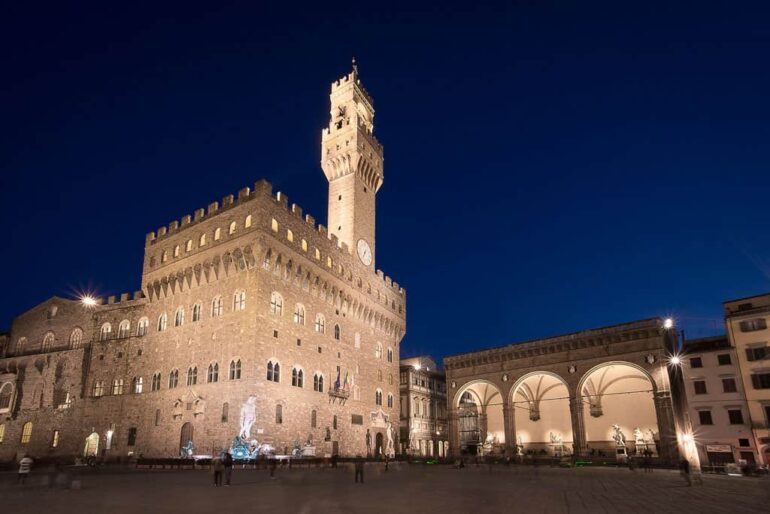Florence’s Open Air Sculpture Museum
Piazza della Signoria has been the political heart of Florence for centuries. Today, with its collection of statues dating from ancient Roman times to the foundation of Italy, it’s something of an open air gallery smack dab in the city center and the most famous square in Florence. As a tour guide passing through this square on almost every tour of Florence, it’s always hard to tear myself away from all the stories contained in these statues. The tale unfolds from Michelangelo’s David to the equestrian statue of the Medici Duke and the construction of the Uffizi Gallery, weaving together the turbulent political intrigues of Florence with some of the city’s most famous artists and scandalous leaders. So before heading to any of the wonderful museums and churches in town, let’s take a stroll through the Signoria Square and get our art fix entirely for free.
INSPIRATION
10 Must Sees In Florence’s Uffizi Gallery
After visiting the piazza, you can continue your tour of the area by visiting the Palazzo Vecchio, Florence’s current city hall and a museum (make sure to climb the tower for the view!), the Gucci Garden museum, on your way to the Ponte Vecchio and of course, you’ll be walking through the piazza to get to the Uffizi Gallery. And if you’d like a more in depth look at Florence, take one of our city tours. Now, let’s get started!
Best of Florence City Center Tour with Accademia and Uffizi
Experience the best of Florence on this private guided tour of the city center. You’ll skip the line at the Accademia Gallery to see Michelangelo’s David before taking in the highlights of the city center from the Cathedral Square to the medieval district, Signoria Square and Ponte Vecchio.
Top Things to Do in Piazza della Signoria
Piazza della Signoria is one of the most famous square in Florence, an open air gallery with Michelangelo’s David, Palazzo Vecchio and more.
Caffe Rivoire
First stop: A fortifying espresso or hot chocolate at Caffe Rivoire. This historic Florentine caffe has been in the square for nearly 150 years and the founder was known as the chocolatier for the royal family of Savoy so when it comes to hot chocolates, they know their stuff. Remember if you sit down in the tea room or the tables out front, you’ll have a sensational view of the piazza but will pay much more than if you order from the cashier to drink your espresso at the marble countertop.
Michelangelo’s David
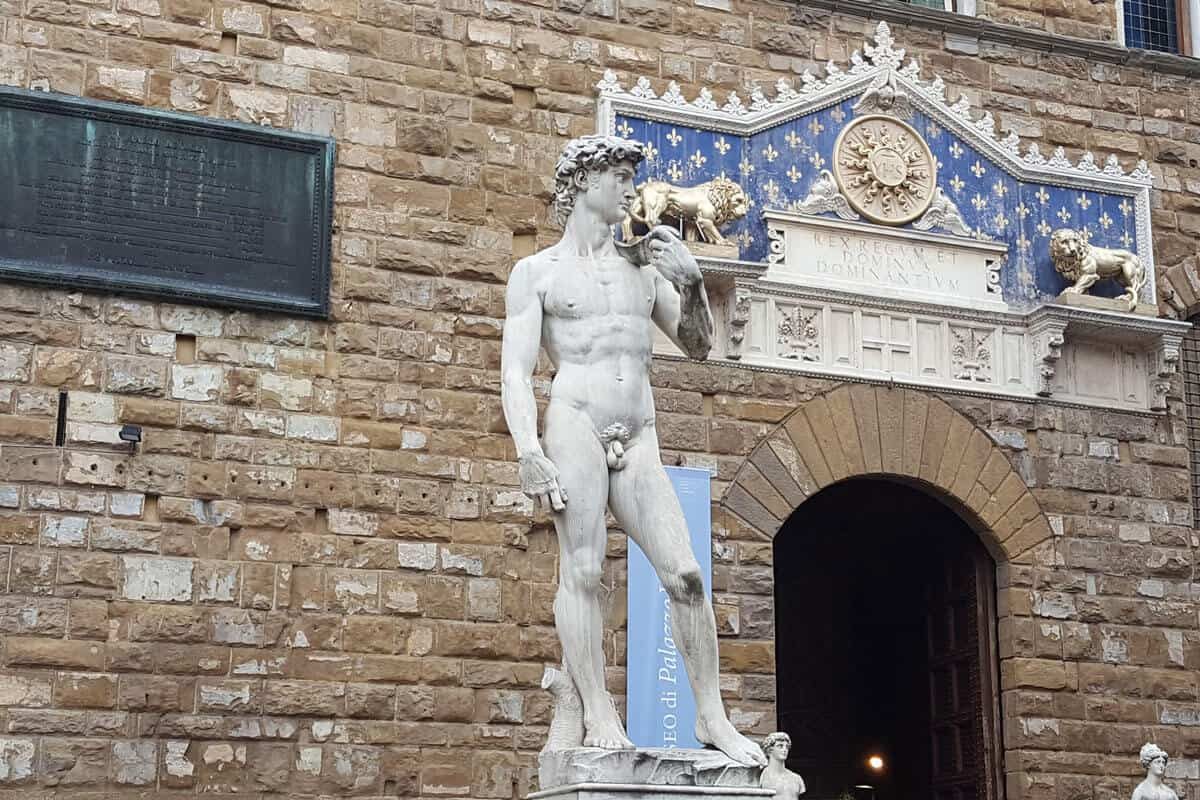
One of the first things that will probably strike you is the statue of Michelangelo’s David just to the left of the entrance to the Palazzo Vecchio. This one is a copy but it stands exactly where the original was placed from 1504 until 1873 when the city of Florence moved this world-famous statue across town to the Accademia Gallery. David, the shepherd boy who defeated the giant Goliath was frequently used as a symbol for the city of Florence herself: small but mighty in the face of all enemies. Michelangelo’s unique portrayal of the familiar Biblical character has become a symbol of high Renaissance art and the democratic spirit of the Florentine Republic.
If David is a symbol of the Republic, you can imagine what happened when the Republic fell in 1530 and Duke Cosimo I de Medici moved into the Palazzo Vecchio. It was time to redecorate… both for the beautification of Florence and the glorification of the Medici family and their new Dukedom.
Hercules and Cacus
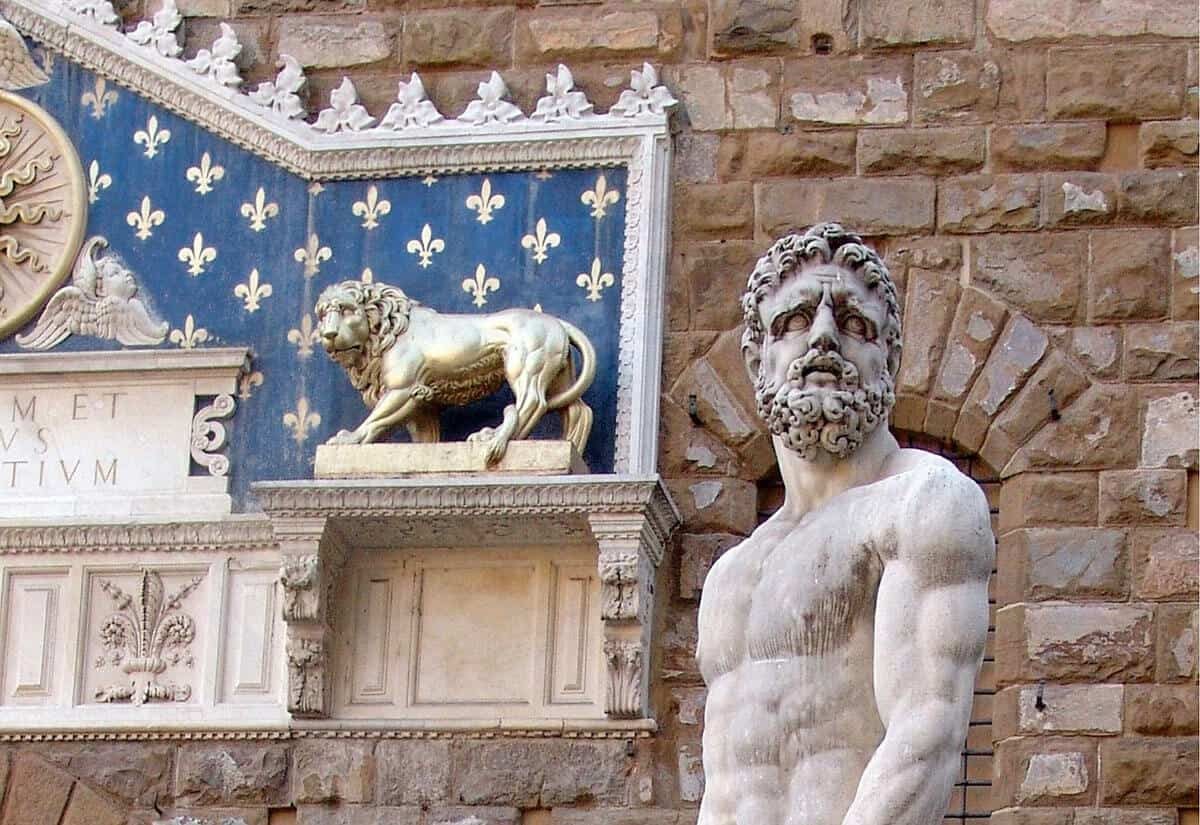
One of two Hercules statues in the piazza, the sculptural group to the right of the Palazzo Vecchio entrance, portrays Hercules and Cacus, a fire breathing giant about to be clobbered by the mythological hero. A not-so-subtle reminder that there’s a new boss in town, the statue sculpted by court sculptor Baccio Bandinelli was criticized for looking like more of a bag of melons than a muscular hero. To be fair, any statue would suffer comparison when it’s placed right next to a Michelangelo.
Fountain of Neptune
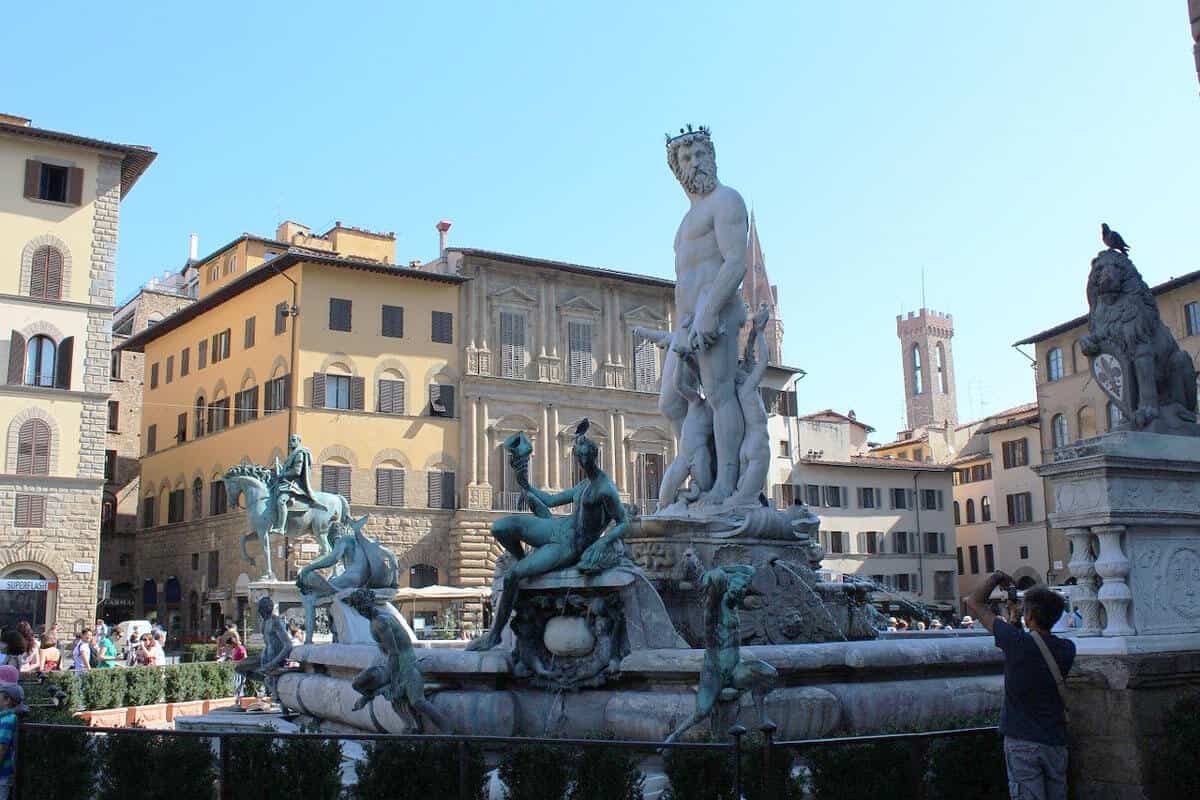
Continuing in the mythological theme of might and majesty, Bartolomeo Ammannati’s Fountain of Neptune (1574) was previously so disliked its actually gone right around again and become a local favorite, both lovingly and deprecatingly called “Il Biancone” (the white giant). Neptune, God of the Sea is surrounded by cavorting nymphs, satyrs, and dolphins, master of the waters (much like Rome’s Trevi Fountain). The statue was erected to celebrate the marriage of Cosimo’s son Francesco I to Joanna of Austria but also to symbolize the Medici domination of water through the construction of a new aqueduct and control of key Mediterranean ports. It’s even said that the face of Neptune is that of the duke himself (God complex, anyone?).
Equestrian statue of Cosimo I
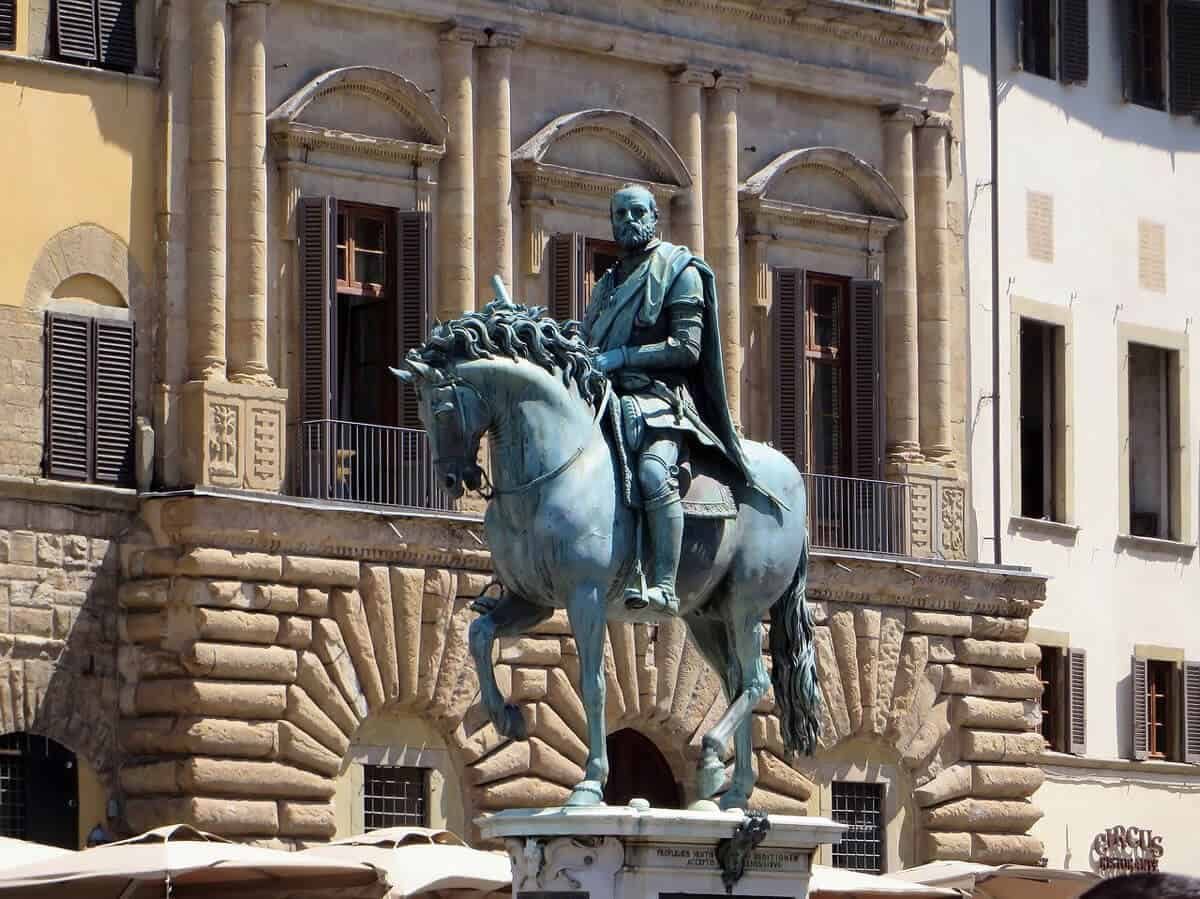
You can compare for yourself by looking over to the grand bronze equestrian statue of Cosimo I cast by Giambologna to look more like an ancient Roman emperor than a Renaissance Duke of Florence.
Loggia dei Lanzi
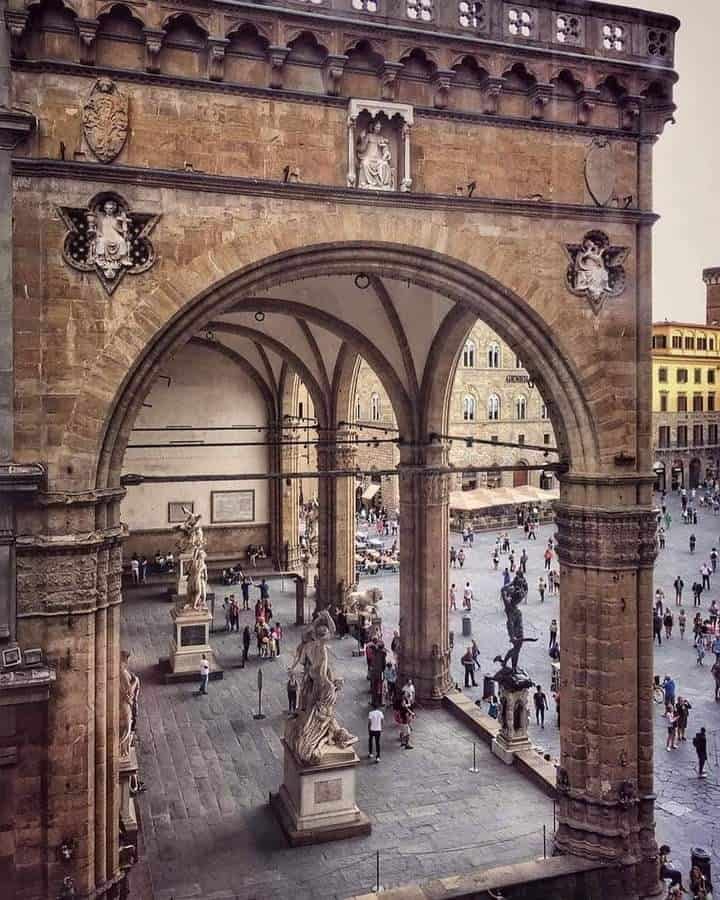
The Loggia dei Lanzi, a wide arched, covered platform on the side of the square, has been there since the 14th century, built by Andrea Orcagna as an outdoor meeting space. You can still see the four cardinal virtues of Fortitude, Temperance, Justice and Prudence in niches at the top. Today, it hosts an array of artworks that trace the development of Italian statuary through the centuries.
Perseus with the Head of Medusa
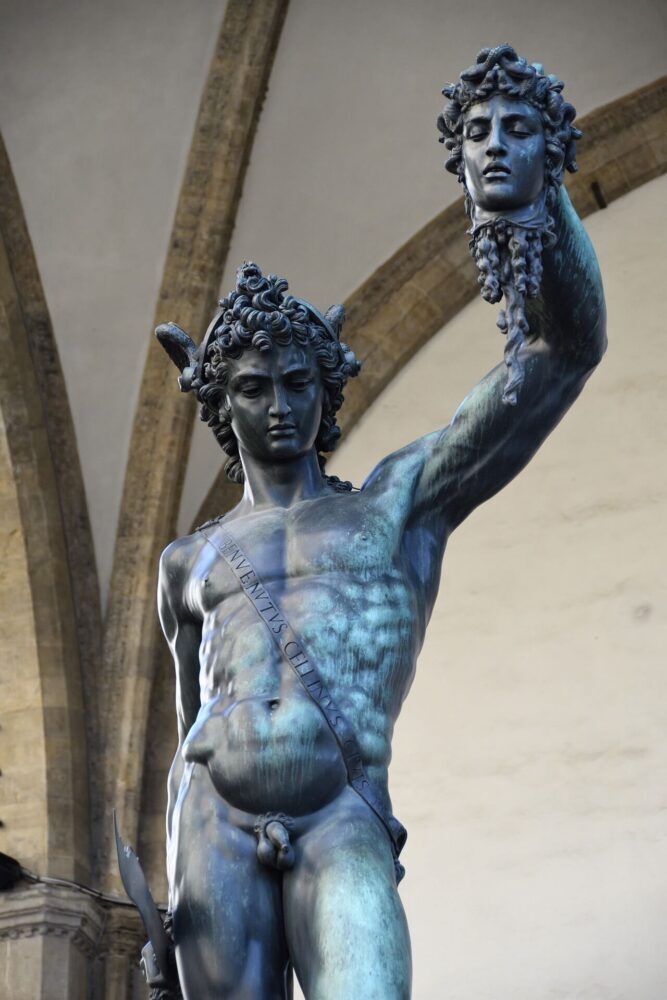
The favorite of the loggia just might be Benvenuto Cellini’s Perseus with the Head of Medusa. While many of the statues in the loggia are copies, this spectacular bronze piece is the original one poured for Cosimo I de Medici in 1554. The ancient Greek hero Perseus holds up the head of defeated Medusa, the woman cursed to have snakes for hair and to turn any man who looked at her into stone. Perhaps it served as a warning never to cross the Medici family. But that’s not the only name being glorified in this statue. Take a look at the back of Perseus’s head and you’ll be able to make out another face – None other than the artist who apparently saw himself as a bit of a legend too.
Donatello’s Marzocco
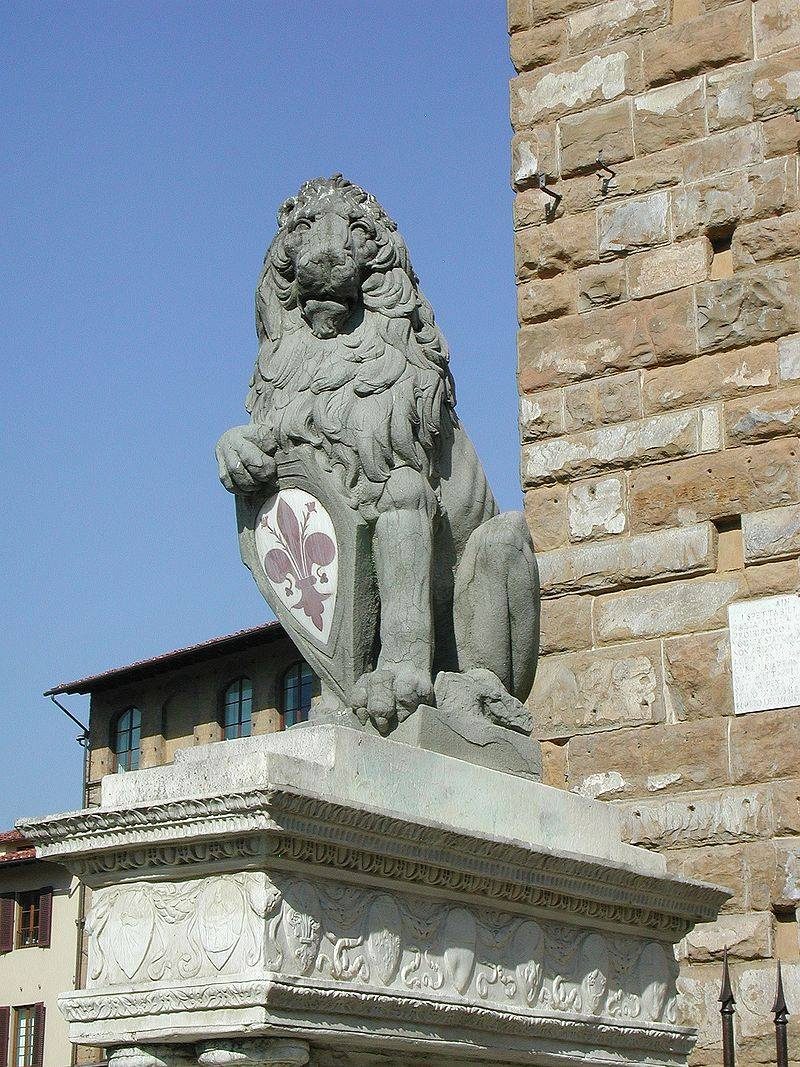
Think you can spot the difference between an ancient roman piece and a Renaissance copy? Lions have long been a symbol of Florence since they actually kept a pair of live lions in cages near the Signoria Square to the copy of Donatello’s Marzocco next to the Fountain of Neptune. But Ferdinando I de Medici was particularly fond of his 2nd century ancient Roman lion and had Flaminio Vacca make a matching one. The lion to the right is the ancient one known as the Fancelli lion since it was reworked somewhat by Giovanni di Scherano Fancelli. The lion to the left is the 16th century Vacca lion. Did you get it right?
Menalaus bearing the Body of Patroclus
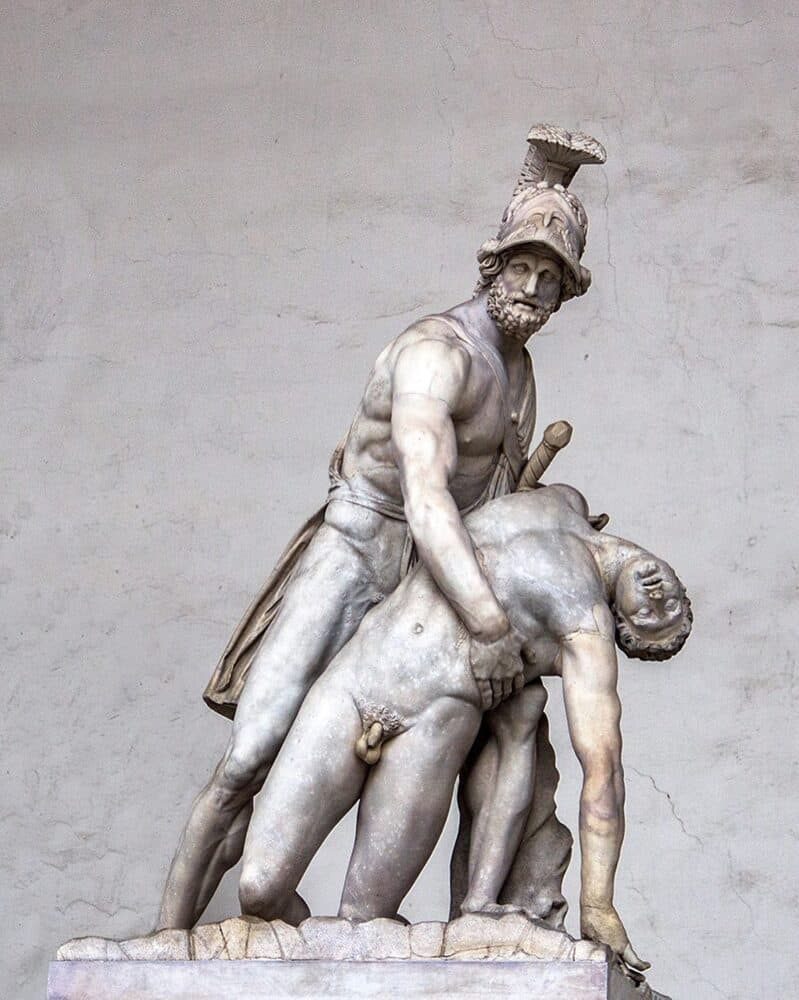
Numerous ancient sculptural pieces from the so-called “Pasquino Group” of Menalaus bearing the Body of Patroclus or Ajax Carrying the Body of Achilles(first century AD) to the Roman women lining the back wall (first and second century AD) serve as the basis of study for much of Renaissance art which Flemish artist Giambologna took to the next level in his two piece on the right hand side of the loggia.
The Rape of the Sabines and Hercules and the Centaur Nessus
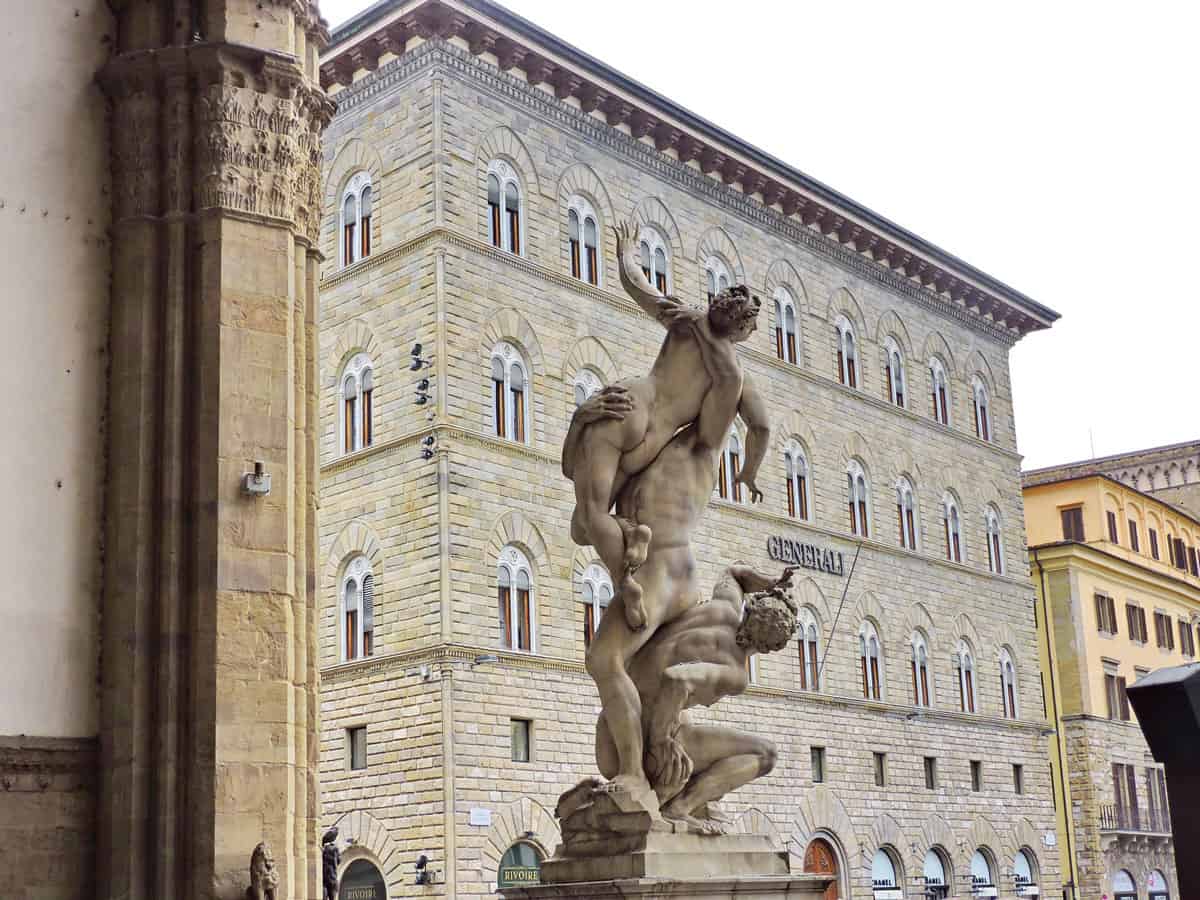
Photo: Dimitris Kamaras (CC BY 2.0) – /www.flickr.com/photos/127226743@N02/
The Rape of the Sabines shows Giambologna’s mastery of the sinuous s-curve leading the eye up, up and around his sensual and powerful statues. These three intertwined figures of two men and a woman, begs you to circle the statue again and again, each turn revealing a different emotion, a different perspective. When it comes to Giambologna’s Hercules and the Centaur Nessus, you can practically feel the spine of the centaur Nessus cracking. Don’t feel too bad for him though. It’s Nessus’s poisoned blood and deceitful lies that led to the death of Hercules.
Rape of Polyxena
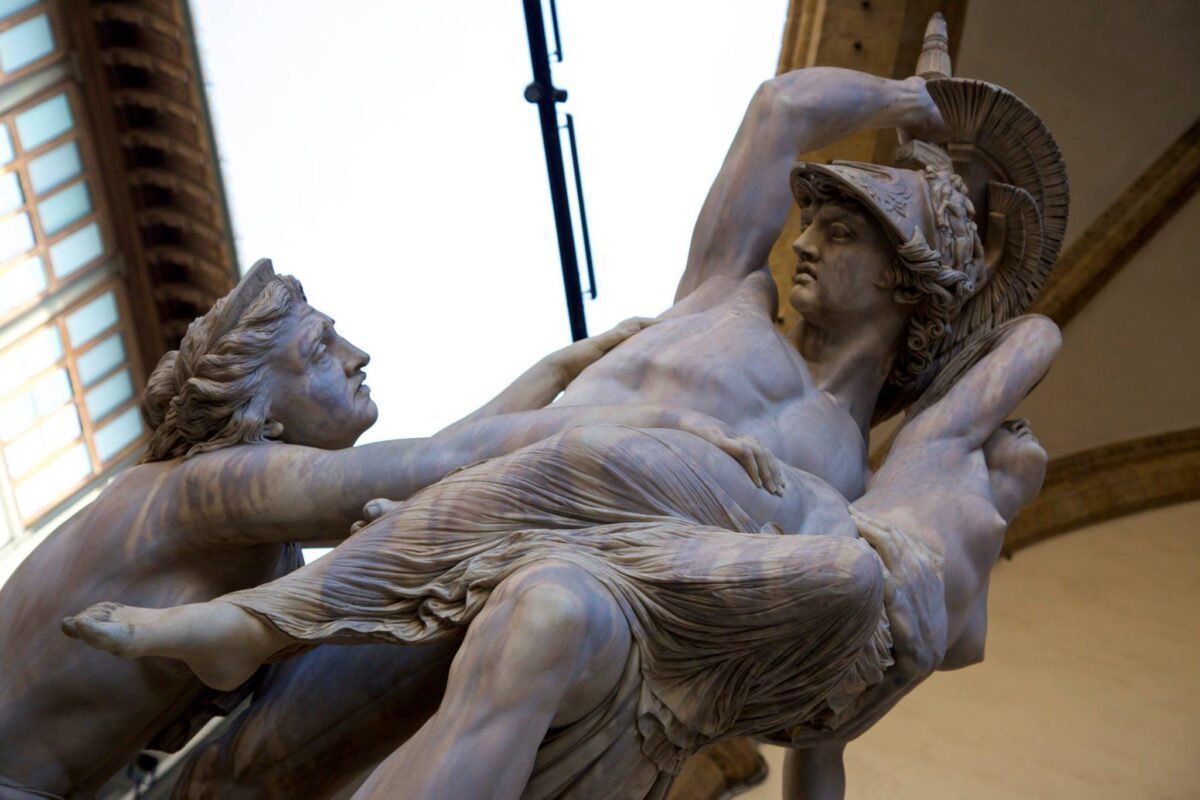
On the left side of the loggia, behind Bellini’s Perseus and Medusa you’ll find the newest statue in the Signoria Square – Pio Fede’s Rape of Polyxena from 1865. Polissena is wrenched away from her pleading mother and brother to be sacrificed on the tomb of Achilles after the fall of Troy, continuing the fascination with the drama ancient myth. If Giambologna was inspired by the twisting movement of Michelangelo’s later work, Pio Fede furthers this study of how to convey emotion and energy in the movement of bodies in stone.
A mysterious face
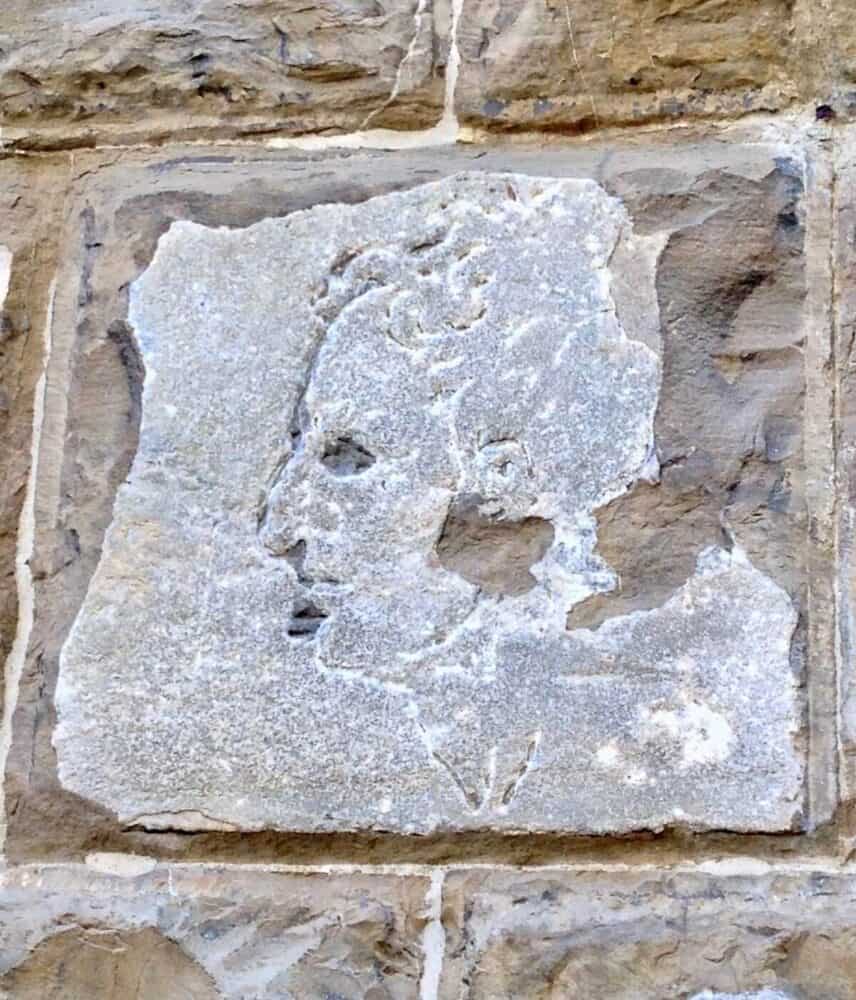
As I’m sure you know if you’ve spent any time in Florence, Michelangelo always gets the last word. Start searching the stone wall just behind Bandinelli’s Hercules and Cacus, to the right of the entrance to the Palazzo Vecchio… and you’ll soon find a mysterious face carved into the stone. Legend has it that Michelangelo himself carved the face to win a bet that said he wouldn’t be able to sculpt a portrait in stone without looking and with his back turned. Whether or not the story is true, you just need to take one look at the expression on the statue of David to know you should never underestimate Michelangelo.
INSPIRATION
Guide to Florence’s Piazza del Duomo


